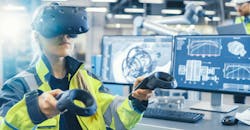Augmented reality (AR) is considered by some managers and business leaders to be critical for creating the smart factories promised by Industry 4.0 (and IIoT). However, manufacturers are often wary of buying into new technology trends, worried that the investment will not generate a tangible return. But AR is one trend that can truly benefit manufacturers, and here are several reasons they should invest in it.
AR Basics
Augmented reality is often confused with virtual reality (VR), but they differ significantly in terms of their applications. VR lets users put on a headset and delve into a virtual world, whereas AR overlays information and digital content on the real world, in real-time, using a display piece or eyeglasses. In essence, it takes the existing environment and adds digital information to it to create the augmented environment.
Use of AR in the factory lets workers easily locate co-workers on the factory floor or know what machinery is operating and if it is within normal parameters. Furthermore, it can improve the production line before components hit the factory floor by streamlining product development, making it less time-consuming and more cost-effective.
Product Development
Traditionally, taking a product from concept through development is a long and resource-intensive process that requires constant communications between several parties and involves numerous revisions of the initial concept. This all takes place before ever reaching mainstream production and manufacturing.
AR reduces the tedious nature of this process by streamlining collaboration between the parties involved. For example, company directors can see the product in development in real-time by using an AR device, letting them offer advice and insights without this causing any delays. Applying AR this way also boosts productivity and efficiency of product development.
Airbus has used a Mixed Reality Application (MiRA) to combine virtual mock-ups into its production line, giving workers access to complete 3D models of the aircraft they are making. They used it primarily to check the integrity of the secondary structural brackets holding hydraulics in place in the A380 fuselage. Airbus reported implementing AR through MiRAs cut the time needed to inspect the brackets from three weeks to just three days.
An AR program on a pad overlays parts numbers and names on an actual image of the device to streamline maintenance.
Maintenance
This technology offers more than just the ability to present digital content such as characters and images. It can also overlay relevant information for users on a screen. For example, looking at a furnace through a set of AR glasses could let workers see information such as its current running temperature or exhaust gas temperature at a glance.
Using AR this way lets manufacturers streamline predictive maintenance programs. It can let workers see the equipment’s potential failure points, letting them quickly see if there is a problem and, crucially, identify which parts are at fault. Replacement parts can then be ordered from a supplier without the need for costly unplanned downtime.
In a factory, even simple maintenance tasks (such as machine servicing) can often be unnecessarily time-consuming because of the amount of administrative work involved. AR lets maintenance crews see exactly which machines and equipment need servicing at a glance by using an AR device to see product data and history, cutting out hours spent digging out the information needed for the task.
Training Factory Workers
Digital twin technology can be combined with AR in manufacturing settings to create virtual clones of a physical asset, providing a dynamic, digital model to show technicians how to service and repair machines on the factory floor. This kind of immersive AR experience lets businesses put in place a more dynamic and cost-effective maintenance training program.
For example, Jaguar Land Rover worked with Bosch using the Reflekt One (Bosch Cap) software to create an iPad app that provides X-ray images of the Range Rover Sport vehicle’s dashboard. This lets them train employees to repair the vehicle without removing, then later reinstalling, the dashboard.
AR will undoubtedly revolutionize manufacturing and companies should give it serious consideration. However, it is important for businesses to remember that to reap the full benefits of AR, it still requires careful obsolescence management, selective equipment upgrades, and a willingness to explore the diverse applications of the technology.
Sophie Hand is country manager (UK) at industrial automation parts supplier EU Automation. For more information call +44 (0) 1785 30 33 00 or click here.


